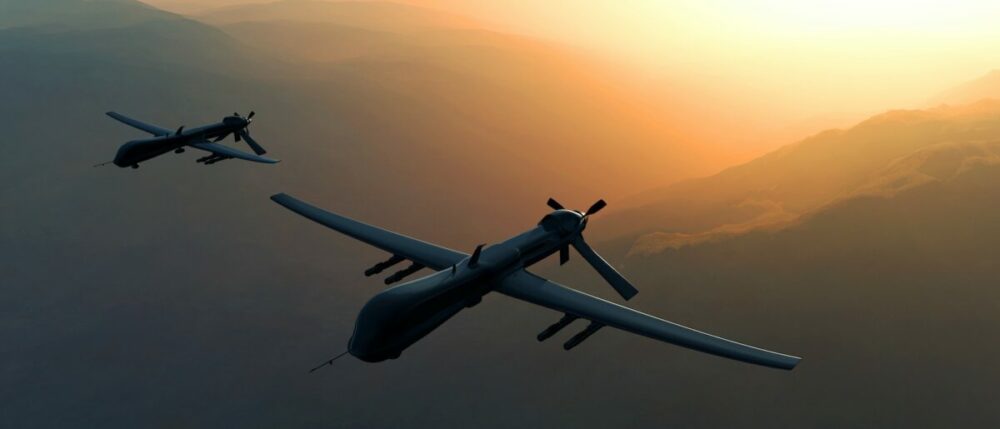
What is energy density?
Energy density refers to how much energy or power can be packed into a set volume or weight. When talking about unmanned aerial systems, often known as UAS or drones, energy density refers to their power source. If the drone is powered by a battery, for example, energy density refers to how much energy that battery contains.
Why is energy density important in unmanned aerial systems?
UAS needs both power and energy to take off, fly, and perform other operations like using cameras or radar. If a UAS needs to be continually brought down to refuel or recharge, the usability is significantly diminished and value propositions are constrained.
Hobbyists who have personal drones likely recognize this as a common occurrence and recreational drone use is almost always relatively short in flight time (typically less than 25 minutes). However, as you will read about further, UAS is used far beyond recreational purposes, often in conjunction with critical missions, and longer flight times, reliable power, and extended flight range are all extremely important characteristics highly valued in these scenarios.
Using batteries to power unmanned aerial systems
Batteries are an obvious power source for UAS for many reasons. There are many types of batteries, in many different form factors, that allow for UAS applications to best optimize for their specific drone application. For instance, a delivery drone may require high power capabilities in order to take off with a payload, while a survey drone may not need as many power capabilities and can instead increase the flight radius of the aircraft.
Furthermore, batteries are energy efficient, regulated to ensure safety, widely available and easy to use. They can be stored and transported, as well as recharged, without significant concerns about refueling.
The goal of battery technology in UAS applications is always to improve gravimetric energy density, typically measured in Wh/kg, to increase the flight time of the UAS without increasing the weight.
What are the challenges with achieving high energy densities in unmanned aerial systems?
UAS of all sizes and types face the same issue: flight endurance. A UAS needs a power source that can last a long time, with a good energy to weight ratio. Current battery energy densities allow for flight but with limited endurance. To work around this limitation, drones are charged practically anywhere with portable power stations or a discharged battery pack is exchanged for one that is fully charged when the drone returns, a.k.a. hot swapping.
Conventional batteries today are capable of enabling UAS to operate, but often at a relatively small radius or limited payload. This is due to the fact that the conventional battery’s gravimetric energy density is too low, generally <300Wh/kg. At this level, adding more batteries to increase usable energy results in more weight, creating a vicious cycle where the energy benefit is offset by the additional weight incurred. This is why advanced battery technologies have become critical in the UAS industry.
How far can unmanned aerial systems travel with current technology?
Drone run time, range, and endurance are not only determined by the type of “fuel” used. The type of terrain or air space, weather conditions including wind, and the materials from which the drone is constructed can also make a difference in flight endurance. The addition of payloads on the UAS further impacts how long a drone can fly.
For an extreme example, the Zephyr Stratospheric UAV is a solar-electric device operating in the stratosphere. As a high-altitude pseudo satellite (HAPS) vehicle it can potentially fly for months continuously, surveilling much like a satellite, before having to return to earth for maintenance and upkeep.
Smaller systems, like the Orion long-endurance UAS, are designed for intelligence, surveillance, and reconnaissance. It uses heavy fuel to operate its engines, offering five days or 120 hours run time. These systems typically require very high power to energy ratios to ensure optimal performance.
Amprius’ battery cells aim to address the needs of the broad UAS industry by providing solutions for both high specific energy applications like HAPS as well as high specific power applications like other UAS systems. Use of Amprius’ battery cells in UAS applications could provide nearly double the flight time when compared to conventional battery solutions.
What are military applications for energy-dense unmanned aerial systems?
Military use of UAS/drones is a prime application for this technology. Some military UAS are very different from the consumer or even commercial drones that you might picture when you hear the word ‘drone.’ Military UAS range from tiny microdrones and mini drones, all the way up to Class III drones that act as combat aerial vehicles.
Forces around the world use this technology to augment, or even to act as, an air force. Military drones are used for surveillance, combat support, and combat itself. Having the ability to stay in the air longer is vital to the success of any UAS-based mission for the military.
Starting in October 2021, Amprius began work with the US Army’s Rapid Capabilities and Critical Technologies Office, prototyping state-of-the-art, high-energy density lithium-ion batteries to be used in UAS applications. Amprius understands that drones need to be lightweight with enough flight time to complete mission critical objectives…and understands that conventional batteries are limited in that capability.
Using Amprius’ 100% silicon anode(1) battery cells via Amprius’ silicon nanowire platform, UAS applications of US military forces will be enabled with significant increased battery performance, nearly doubling flight time.
What are commercial applications for energy-dense unmanned aerial systems?
Drone delivery is an increasingly popular application for UAS. While these systems can be used to deliver medical supplies, food, and other much-needed goods, on the commercial side, drones are useful for simply getting packages to people who have ordered them.
Companies around the world have trialed drones for postal delivery. Amazon Prime Air is one such example, designed to get packages to buyers in 30 minutes or less using autonomous aerial vehicles. The concept was founded in 2016 and in late 2020, the FAA selected Amazon, along with other organizations, to participate in a certification program.
Amazon intends to use small drones to complete deliveries under five pounds. These UAS will fly at low altitudes, using sense and avoid technology. The company expects to scale Prime Air quickly when it finally launches.
Walmart recently announced expanded drone deliveries with their operator, DroneUp, showing that the use of UAS for commercial delivery purposes is growing. The retailer intends to reach 4 million households in Arizona, Arkansas, Florida, Texas, Utah and Virginia, fulfilling orders from 37 stores. Presently, the company uses drones to deliver from a few stores in Arkansas and North Carolina.
Under their setup, customers who live within range can order deliveries up to 10 pounds for a fee. While the company thought that many would use it for emergency items, they found that convenience is major driver as well — Hamburger Helper, for example, is a top drone delivery at one store.
High energy density is as important for commercial delivery as it is for military purposes when it comes to UAS. While Hamburger Helper may not be mission-critical in the same way that military reconnaissance or aid is, it is important to the company’s bottom line. They require drones that have a wide service radius, manage a reasonable payload, and work reliably day in and day out.
The more advances made in energy density for UAS, the more likely we are to see organizations try innovative solutions like drone deliveries.
Are there other applications for energy-dense unmanned aerial systems?
While military and commercial applications for unarmed aerial systems are usually foremost in people’s minds, there are many other uses for drones! From agriculture to photography, to forensics, mining, and meteorology, there are countless applications for drones. Both commercial and recreational drones are popular because UAS are as fun as they are useful.
Here are a few particularly interesting uses:
Drones are used for geographic mapping, downloading imagery in hard-to-reach places like mountaintops and islands. The same technology works for wildlife monitoring and management, for research purposes and to protect animals from threats like poachers.
Disaster management is another key use for an unmanned aerial system. A UAS can move through harsh conditions and tricky terrain where larger vehicles could not travel safely.
These unmanned vehicles gather information with cameras, sensors, and radars to look for injured victims and otherwise search for much-needed data. Thermal sensors and night vision aid in search and rescue.
Then, rescuers can move in with the most up-to-date details, saving resources and lives. Drones can also drop supplies for disaster management or search and rescue situations while a team works on getting to victims.
Whether a UAS is used for spraying crops or used to find someone in a rescue scenario, energy density matters. In all applications, drones should be reliable, offer a reasonable range and run time, and reach a good balance between cost and energy density.
What is the future of energy-dense materials in unmanned aerial systems?
Battery cells like those offered at Amprius offer industry leading energy density. These lithium-ion battery cells are expected to extend the use cases for almost all UAS applications currently using batteries to power flight.
Research, development and ingenuity led to Amprius’ 100 percent silicon anode(1), providing the highest known energy destiny in the industry. Using Amprius’ battery cells, flight time for a UAS will be nearly doubled and Amprius plans to further leverage their silicon nanowire platform for UAS and other battery-powered technologies.
(1) Actual percentage of silicon is 99.5-99.9% which is within the range of acceptable purity levels for materials that are considered 100%
